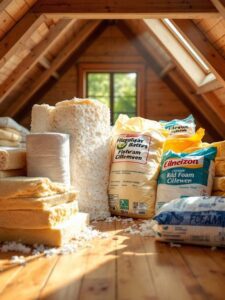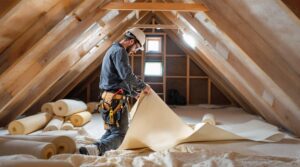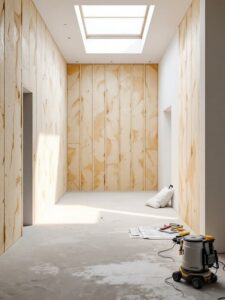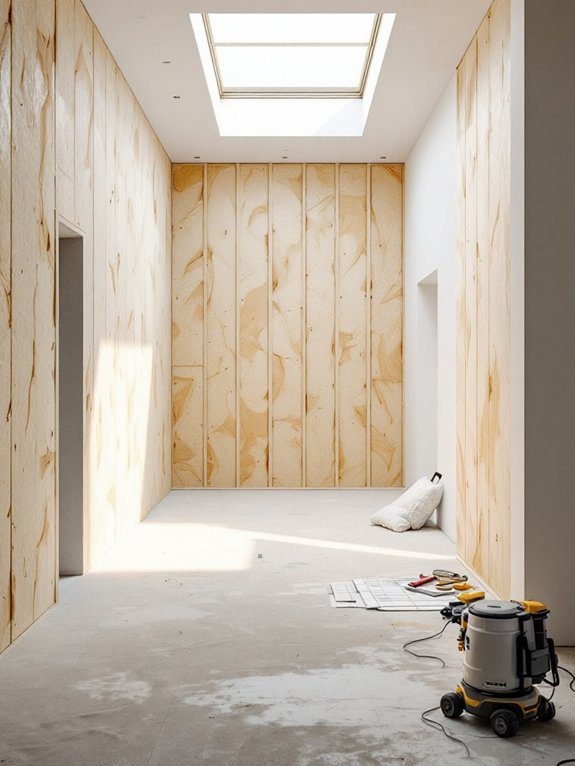You’ll find several effective cavity wall insulation options in the UK, including mineral wool, EPS foam boards, polyurethane foam, and glass wool. Costs typically range from £20-£50 per square meter, with installation taking 2-4 hours for an average home. Your best choice depends on your property’s specific requirements and budget, as each material offers different thermal performance ratings and moisture resistance properties. Professional assessment by a certified contractor will help determine your ideal insulation solution.
Key Takeaways
- Mineral wool offers excellent thermal performance with U-values around 0.32 W/m²K and superior fire resistance at £20-30 per square meter.
- Installation costs typically range from £20-50 per square meter, with professional installation taking 2-4 hours for average UK homes.
- Polyurethane foam provides the best thermal performance (U-value 0.16 W/m²K) but comes at a premium price point.
- Government schemes like ECO and Green Homes Grant can significantly reduce installation costs for eligible households.
- Professional survey assessment is mandatory before installation to evaluate wall condition and determine suitable insulation material.
Types of Cavity Wall Insulation Materials Available in the UK

Homeowners in the UK can choose from several proven cavity wall insulation materials, each offering distinct performance characteristics and installation requirements.
The most common options include mineral wool, also known as rockwool, which provides excellent thermal and acoustic properties while remaining fire-resistant and moisture-repellent.
You’ll find expanded polystyrene (EPS) foam boards offer another reliable solution, delivering high thermal performance with their rigid, closed-cell structure.
These boards are particularly effective in maintaining consistent cavity width and preventing thermal bridging.
Other popular choices include polyurethane foam, which expands to fill gaps completely, and glass wool, which combines cost-effectiveness with reliable insulation properties.
Each material requires professional installation by certified contractors who’ll assess your home’s suitability and guarantee compliance with building regulations.
Comparing Costs and Installation Requirements
When comparing cavity wall insulation options, you’ll find significant cost variations ranging from £20 to £50 per square meter, depending on your chosen material and property size.
Installation timeframes typically span 2-4 hours for an average UK home, though cost factors can influence your final decision.
Key considerations for your installation include:
- Professional installation requirements, as DIY isn’t permitted under UK building regulations
- Property size and wall condition assessment fees, which can add £100-£200 to total costs
- Access requirements and scaffolding needs, particularly for homes over two stories
You’ll need to factor in a surveyor’s inspection before installation begins.
Most installations come with a 25-year guarantee through the Cavity Insulation Guarantee Agency (CIGA), ensuring your investment is protected for the long term.
Benefits and Performance Ratings of Different Materials

Understanding cavity wall insulation materials starts with their thermal performance ratings, measured in U-values and R-values.
You’ll find that mineral wool offers excellent thermal efficiency with U-values around 0.32 W/m²K, while also providing superior sound insulation and fire resistance.
EPS beads achieve similar performance but are particularly effective for moisture control in challenging climate zones.
Polyurethane foam delivers the highest thermal performance, reaching U-values as low as 0.16 W/m²K, though it’s typically more expensive.
When you’re comparing materials, consider that rock wool and glass wool maintain their performance longer than alternatives, with minimal degradation over time.
Your choice should balance immediate thermal benefits against long-term efficiency, as superior materials can reduce your heating costs by up to 35% while maintaining consistent cavity ventilation.
Potential Risks and Material-Specific Considerations
Despite their numerous benefits, cavity wall insulation materials can present specific risks that you’ll need to evaluate before installation.
Understanding these challenges will help you make informed decisions that protect your home’s integrity and your investment.
Common risks you should consider include:
- Moisture concerns if your property has damaged brickwork or isn’t suitable for cavity insulation, potentially leading to damp issues
- Reduced air circulation within wall cavities, which can affect your home’s natural ventilation patterns
- Material-specific vulnerabilities, such as mineral wool’s compression over time or foam’s potential shrinkage
To minimize these risks, you’ll want to have a qualified surveyor assess your property’s suitability before proceeding.
They’ll check your walls’ condition, existing moisture levels, and cavity width to determine the most appropriate insulation solution for your home.
Government Grants and Support for Cavity Wall Insulation

If you’re looking to improve your home’s energy efficiency, several UK government initiatives can help offset the cost of cavity wall insulation.
The Energy Company Obligation (ECO) scheme provides substantial financial incentives, particularly if you’re receiving certain benefits or live in a low-income household.
You’ll find grants availability varies by region, with local authorities often offering additional support through their own energy efficiency programs.
The Green Homes Grant Local Authority Delivery scheme supports eligible households with incomes under £30,000. You can check your eligibility through the Simple Energy Advice service or your local council.
If you’re a landlord, you might qualify for specialized funding to upgrade your rental properties’ insulation to meet Minimum Energy Efficiency Standards (MEES).
Contact certified installers who can guide you through the application process for these schemes.
Frequently Asked Questions
How Long Does Cavity Wall Insulation Typically Last Before Needing Replacement?
You’ll get 25+ years from your installation lifespan with proper maintenance requirements. Once professionally installed, you won’t need to replace it unless there’s damage, and it’ll keep performing effectively throughout your home’s lifetime.
Can Cavity Wall Insulation Be Removed if Problems Occur After Installation?
Yes, you can remove problematic insulation through a professional removal process. If you’re experiencing insulation complications like damp or cold spots, specialists will extract the material through small holes in your wall’s exterior.
Will Cavity Wall Insulation Affect My Home’s Resale Value?
Yes, your home’s resale value will typically increase with proper insulation. You’ll benefit from enhanced energy efficiency and comfort, which are key selling points that today’s energy-conscious buyers actively seek in properties.
Does Cavity Wall Insulation Work Effectively in Listed or Heritage Buildings?
You’ll need special approval for heritage buildings, as traditional cavity wall insulation isn’t always suitable. Work with conservation specialists to find alternative insulation benefits that respect your property’s historic character while improving energy efficiency.
Can I Install Cavity Wall Insulation During Winter Months?
You can install during winter, but you’ll face specific insulation challenges. It’s best to choose dry, frost-free days when temperatures are above 5°C to guarantee proper material flow and effective installation results.
Conclusion
Cavity wall insulation remains one of the most cost-effective ways to reduce your home’s energy consumption, with potential savings of up to £250 annually on heating bills. By choosing the right material for your property—whether it’s mineral wool, polystyrene beads, or foam—you’ll guarantee peak performance while meeting current building regulations. With government grants covering up to 75% of installation costs, there’s never been a better time to upgrade your home’s thermal efficiency.









10 Responses
Hello.This post was extremely fascinating, especially since I was searching for thoughts on this matter last week.
you’re truly a just right webmaster. The site loading velocity is amazing. It sort of feels that you’re doing any unique trick. Furthermore, The contents are masterwork. you’ve performed a great task in this matter!
hi!,I love your writing so a lot! percentage we be in contact more approximately your article on AOL? I need an expert on this house to solve my problem. Maybe that is you! Taking a look forward to see you.
Great post. I am facing a couple of these problems.
Your point of view caught my eye and was very interesting. Thanks. I have a question for you.
Thank you for sharing superb informations. Your website is very cool. I am impressed by the details that you have on this blog. It reveals how nicely you understand this subject. Bookmarked this web page, will come back for extra articles. You, my friend, ROCK! I found just the info I already searched everywhere and just couldn’t come across. What a perfect website.
naturally like your website however you have to take a look at the spelling on several of your posts. A number of them are rife with spelling problems and I in finding it very troublesome to inform the truth nevertheless I will definitely come back again.
Your article helped me a lot, is there any more related content? Thanks!
Your point of view caught my eye and was very interesting. Thanks. I have a question for you. https://accounts.binance.info/register-person?ref=IHJUI7TF
I don’t think the title of your article matches the content lol. Just kidding, mainly because I had some doubts after reading the article. https://www.binance.com/ru/register?ref=O9XES6KU